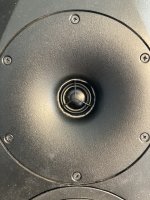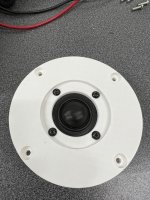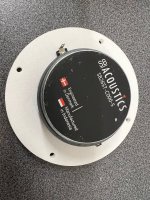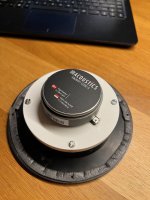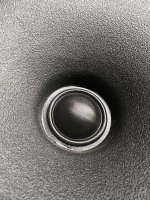The adapter I used for bare SB26 units, without the faceplate. This version is not perfect as the original screws for mounting the faceplate are a bit short. I have measurements somewhere...
This is not the ADC but the ST of course.
This is not the ADC but the ST of course.
Attachments
Hi markbakk
Yes the mouth of both the WG300 and the WG148 is 38 mm and optimally it should be something like 31 mm to match the SB26.
So for sure a custom made WG could be made to fit perfectly as the one from Augerpro.
Wondering whether the adaptor plate could be made to extend the mouth and smooth it to the needed 31 mm?
Also wondering if it would make more sense to make a mold for creating the WG in fiberglass in stead .....
Yes the mouth of both the WG300 and the WG148 is 38 mm and optimally it should be something like 31 mm to match the SB26.
So for sure a custom made WG could be made to fit perfectly as the one from Augerpro.
Wondering whether the adaptor plate could be made to extend the mouth and smooth it to the needed 31 mm?
Also wondering if it would make more sense to make a mold for creating the WG in fiberglass in stead .....
I’m not so certain a deeper throat on the WG300 would work with regular dome tweeters. They are not designed to drive higher acoustic impedances and likely the output at high frequencies will disintegrate. In fact that is what you see already with this WG. In the implementation above I had to lift response around 13k quite a bit to regain on axis linearity. It doesn’t stay clean off axis either, as Pida's and my measurements have shown me. That is hardly a problem though.
SB26 ADC with phase shield in WG300, baffle 21x39cm, no chamfering. I used an 8mm thick adapter piece of laminate flooring here...

Looks not that different from Pida's measurements in post #9 https://www.diyaudio.com/community/...sb26cdc-wg300-combination.400833/post-7390992
There is the distinct dip around 10kHz, but that can also be seen somewhat similar on Augerpro's WGs
There is the distinct dip around 10kHz, but that can also be seen somewhat similar on Augerpro's WGs
What is obvious is that the WG300 already starts working at around 1kHz, which is quite a bit lower than the shallow Augerpro waveguides. That comes in handy if one has to cross quite low, at say 1,5kHz. The tradeoff as ever with horns being that you sacrifice a bit at the top end.
My measurements are on a largish test baffle, and the low frequencies will be very different on a typical speaker baffle. Here is the SB26CDC on the 6" waveguide on the two baffles (ignore the response above 20khz, I've tweaked the HBT tailing of the mic cal file above there):
Standard test baffle:

Actual speaker baffle:

The baffle itself is a waveguide, so we have to remember apply its impact when comparing measurements.
PS: this the no phase shield version. With phase shield there is less of a dip at 13khz in the 0-20 degrees axes.
Standard test baffle:
Actual speaker baffle:
The baffle itself is a waveguide, so we have to remember apply its impact when comparing measurements.
PS: this the no phase shield version. With phase shield there is less of a dip at 13khz in the 0-20 degrees axes.
Last edited:
- Home
- Loudspeakers
- Multi-Way
- Adaptor Plate for SB Acoustics SB26ADC/SB26CDC, WG300 combination
